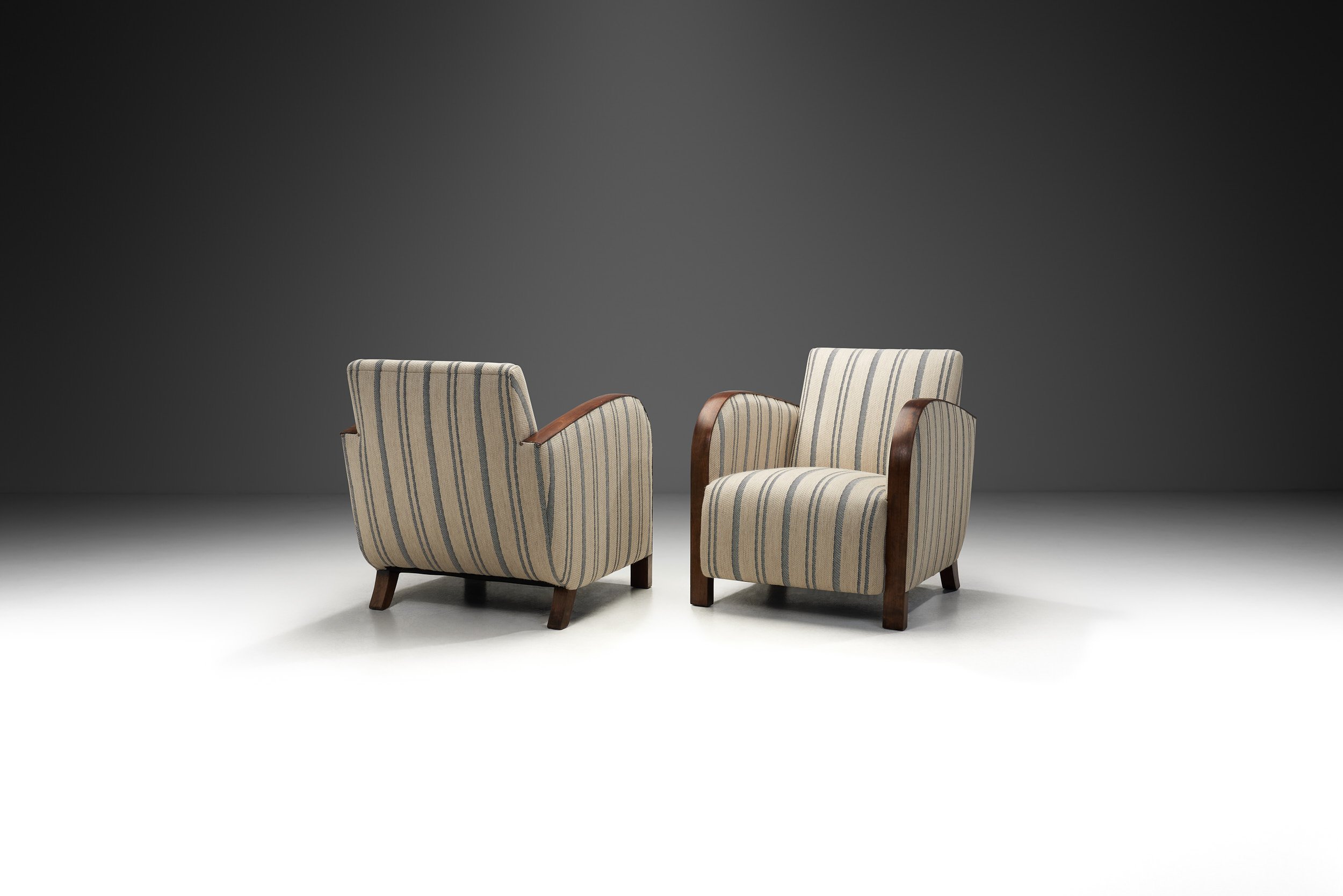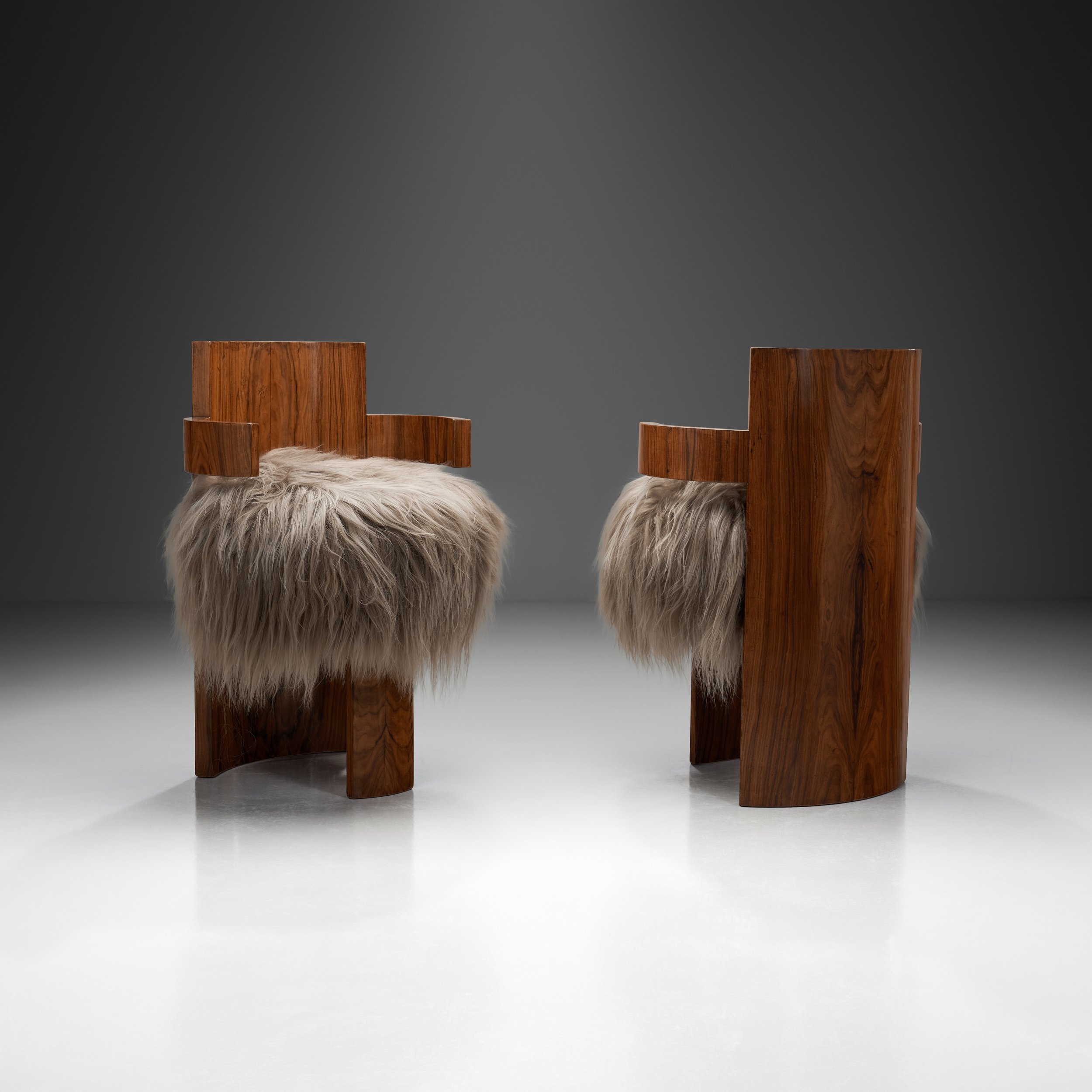Jindřich Halabala Lounge Chairs for UP Závody, Czechoslovakia 1930s (sold)















Jindřich Halabala Lounge Chairs for UP Závody, Czechoslovakia 1930s (sold)
This pair of rare Jindřich Halabala lounge chairs feature the world-famous Czech designer’s most well-known design element: the steam bent, curved arms. This model exemplifies why Halabala's work is considered to be a connection between innovative Czech cubism from the 1910s, Art Deco from the early 1920s and European modern art after the Second World War.
Jindřich Halabala was born into the family of carpenter Štěpán Halabala, whose craft he learned in a family business between 1918 and 1920. Thus, it comes as no surprise that Halabala remains known as the Czech master of wood. The designer’s chairs such as this pair carries design elements from art deco as well as early mid-century design, resulting in a unique and immediately recognizable aesthetic that’s based on daring shapes and forms. The design of these chairs features a sensual curved wooden frame that contrasts beautifully with the angular, fully upholstered seats and backs. Further strengthening the transition into a more minimalistic modern aesthetic, these chairs don’t have any ornamentation. What really sets this model apart from the rest of Halabala’s impressive repertoire are the sledge-like legs. The arms don’t connect to the legs directly, nonetheless, the wooden frames remain flowing and dynamic. The luxurious light upholstery covering the bodies contrast beautifully with the dark wooden frames and accentuate the curves of both the arms and the legs. UP Závody—an acronym for Czech furniture manufacturer Spojené uměleckoprůmyslové závody (or, Associated Arts & Crafts Enterprises, in English)—was founded in Brno in 1920. From the late 1920s, the firm’s fresh-faced and precocious development director, Jindřich Halabala led the company’s product promotion and sales strategy until 1946. On the heels of Halabala’s success, by 1937, UP had grown into Europe’s largest furniture manufacturer—with a reputation synonymous with good taste and quality.
This pair of lounge chairs offers the optimum combination of superior design, functionality, and efficiency. While excessively rare, this model with gorgeous bentwood arms is still widely attributed to Halabala. He was one of the most progressive and timeless architects worldwide and remains a great happiness that many of his works are still around.
SOLD
Condition:
In very good vintage condition. Wear consistent with age and use. The chairs have been reupholstered recently in a premium taupe velour fabric. Each of our items can be re-upholstered by our in-house atelier in a fabric of choice. Please reach out for more information.
Dimensions:
27.55 in W x 35.82 in D x 32.87 in H ; Seat height 15.74 in; Arm height 25.78 in
70 cm W x 91 cm D x 83.5 cm H ; Seat height: 40 cm; Arm height 65.5 cm
About the designer:
Jindřich Halabala (May 24, 1903 Koryčany - November 18, 1978 Brno) was a Czech furniture designer, theorist, publicist and pedagogue. He was especially famous for his designs of stylish furniture for the Brno UP plants from 1925 to 1955, where he worked as a chief designer. Thanks to this position, he fundamentally influenced the appearance of interwar and post-war Czech households.
Jindřich Halabala was born on May 24, 1903 in Koryčany to the family of carpenter Štěpán Halabala, whose craft he learned in a family business between 1918 and 1920. He then joined the State Czechoslovak Vocational School for Wood Processing in Valašské Meziříčí, which he graduated from two years later. After school, he started practicing at the United UP races, where he met their founder Jan Vaňek. In 1922 he also began to study architecture at the School of Applied Arts in Prague, specializing in furniture and interiors with prof. Pavel Janák. He completed his studies in 1926. In the same year, he created the first designs for furniture and carpets. In 1927, he was briefly employed in Bohumil Hübschmann's studio in Prague, and in 1928 he finally joined the United UP plant as the head of the Prague store in the Lucerna Palace. In 1927, Jindřich Halabala married Pavla Sekerková, with whom he had two sons; in 1929 son Jindra and in 1935 son Ivan. In 1930, he was transferred to the Brno headquarters of the United UP plant as head of the studio, where he worked in various positions (procurator, director) until 1946, and thus fundamentally contributed to a comprehensive concept of production, promotion, and sales. Later, he became interested in passing on his knowledge to future generations and between 1951 and 1954 he lectured externally at the Faculty of Forestry and Wood Engineering at the VŠPDI in Košice. In 1954, he was appointed an extraordinary (and a year later also a full) professor and began his long-term work at the Faculty of Wood Science of the University of Forestry and Wood Technology in Zvolen, where he founded and headed the Research Institute. He worked here until 1970, when he retired.
Halabala's work is considered to be a connection between innovative Czech cubism from 1910, art deco from the early 1920s and European modern art after the Second World War. His commercially successful designs were strongly based on the design of the Bauhaus. Halabala designed a variety of furniture, including chairs, tables, sideboards, chests of drawers, flower stands, coffee tables and lamps. Especially his legendary chair H-79 with frames made of bent steel tubes and his armchair type H-269 enjoyed great popularity. ~H.






















